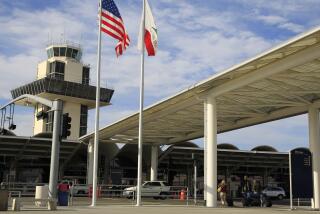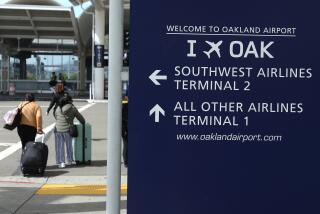3-Year Noise Variance for Van Nuys Airport OKd
- Share via
Van Nuys Airport has won a three-year noise variance--a crucial state operating permit--despite efforts by a homeowners group to reopen a hearing on the issue.
A spokesman for the Los Angeles city attorney’s office said Friday that the conditions on the variance, agreed to in August but later disputed by a residents group, Ban Airport Noise, were fair.
“We’d like them to be happy out there, but there are limits to what you can do to make them happy,” said Gary R. Netzer, senior assistant city attorney. “You can’t shut the airport.”
But Don Schultz, president of Ban Airport Noise, or BAN, said the state Department of Transportation had backed down from stricter noise limitations under threat of city litigation.
Given ‘Green Light’
“They gave them the green light to go ahead and do whatever they want to do under the guise of a variance,” Schultz said.
Schultz said his group is looking into the possibility of suing the city and the state over the variance.
Van Nuys Airport needs a variance--a Caltrans permit to continue operating without meeting state noise control standards--because, like many airports in residential areas, it cannot meet stricter state noise limits imposed in 1986.
BAN asked for a hearing by the state, seeking stricter limits on air traffic as a condition for granting the variance to the city-owned airport.
Under a recommendation issued in July by a state administrative law judge, the city would have been barred from increasing the size of the airport’s noise “footprint”--the zone around the airport where noise levels reach or exceed state limits. The judge also recommended that areas near the airport, which include 26 homes and 151 apartments, be rezoned for industrial and commercial uses.
BAN had requested that the state tighten the city’s night air traffic curfew, which bans most takeoffs between 11 p.m. and 7 a.m. But a 1979 lawsuit involving a San Diego airport found that the state did not have the right to impose curfews, said Larry Thelen, attorney for Caltrans’ Division of Aeronautics.
Following the July recommendation, the city threatened to sue the state for overstepping its authority.
A hearing involving the city, state and BAN representatives was held in August, leading to an agreement that the variance would be granted on condition that the city proceed with an already scheduled federal noise study and consider paying for sound-deadening insulation for some nearby residences.
Changed Mind
Schultz said he initially agreed to the settlement, but changed his mind after he learned that an office and private jet hangar development proposed at the airport by the Retlaw Corp. would extend the noise footprint’s perimeter by about 20 feet, according to state calculations. With the help of state Sen. Alan Robbins (D-Tarzana), Schultz appealed to Caltrans to reopen the hearing.
However, Thelen said the city proved to Caltrans that Schultz knew about the Retlaw development before the August meeting. He also described the increase in noise from the project as minimal and perhaps undetectable.
Schultz acknowledges that he knew about the project but said he did not know how much noise it would generate.
“Anyway, from my understanding, the state’s responsibility is to get the airport to decrease the noise level, not to allow it to increase, no matter how little,” he said.
The variance expires in August, 1991, three years from when the agreement was first reached.
More to Read
Sign up for Essential California
The most important California stories and recommendations in your inbox every morning.
You may occasionally receive promotional content from the Los Angeles Times.













